Page 1 of 2
STUDENTS AS MUSEUM SCIENTISTSDONALD L. LOFGRENINTRODUCTIONTHE TYPICAL visitor thinks of a natural history museum as a place to go to view interesting displays. They expect to come away from the experience with increased knowledge and appreciation of the educational message of each exhibit. However, few visitors are aware that a natural history museum is much more than exhibits. Typically, such a museum has less than five percent of its specimens on display. What function does the other ninety-five percent serve? How are specimens obtained? What happens to specimens once they are included in a museum's permanent collections? These are questions which few visitors think about as they view displays in a natural history museum.
In keeping with the tradition of student involvement in museum activities, students at The Webb Schools learn about paleontology and museum work through hands-on activities in Museum Studies, a course offered through the Science Department. The course is designed to expose students to the tasks of a museum scientist working in a paleontology. Students learn how specimens are procured, cared for, and used to further the mission of the Alf Museum.
The activities that students are involved in during the course are shown in Figure 2, the components of which are described and discussed in the remainder of this paper. It is hoped that the description/discussion of the activities of The Raymond M. Alf Museum of Paleontology will provide insight and a greater appreciation of museums to both educators and their students.
PROCUREMENT OF FOSSILSLike most museums, the Alf Museum desires to add specimens to its permanent collections because the size and uniqueness of a museum's collections partially defines its stature in the museum field. However, before adding specimens, staff must follow institutional guidelines concerning how specimens are to be obtained and what type of specimens should be procured. New specimens should further the mission of the museum. Guidelines for obtaining specimens are outlined in a written document, called an Accessions Policy. The Accessions Policy describes the type of specimens that fits the mission of the museum and what specimens are inappropriate to include. However, accessions policies, by necessity, are usually somewhat vague and the ultimate decision on which specimens will be added to the collections rests with staff.Specimens are obtained by the Alf Museum in three main ways: Field Collection by staff and students (comprising over 95 percent of the collections); Donations (approximately four percent of the collections); and Purchase (less than one percent of the collections). Collection — The Alf Museum has a long tradition of student involvement in paleontological fieldwork. Students accompany museum staff throughout the Western United States collecting fossils at various sites. Before the museum mounts a field expedition, ownership of the land from which the fossils will be collected must be determined. If a fossil site is on privately owned land, the permission of the property owner must be obtained prior to the onset of fieldwork. If collecting on public lands, there are regulations which must be followed and permits may be required. Public lands are regulated by many different government agencies and the expedition leader must first determine which agency to contact and then inquire about regulations. For most types of public lands, permits are required to collect vertebrate fossils because they are considered as rare or unique specimens needing special protection, similar to archaeological artifacts. With regulation, the government is able to oversee collection so that vertebrate fossils from public lands will be accessioned into the permanent collections of museums open to the public. To collect invertebrate or plant fossils, permits are usually not required (unless collecting in a specially protected area, e.g.,. National Park or National Monument).
Once the trip leader has determined land ownership and receives permission to conduct
fieldwork, the expedition is ready to proceed. However, collecting fossils involves more than
finding specimens and bringing them back to the museum. After collection, fossils must be
prepared (cleaned, repaired) and curated (organized for storage in the collections). Curation
of fossils is accomplished back at the museum, but proper curation is heavily dependent on
how precise the field data is that accompanies each specimen. A collector must take good
field notes while at the site. This insures that specimens can be curated at a professional level. It is very important to record data pertaining to the specific location of the site in both
geographic and geologic terms. The Alf Museum derives locality information directly from
field notes: written descriptions, map plots, and photos. Once the collection site is written up, specimens can be assigned a specific locality number and stored. On collecting trips, students and staff collect from both existing Alf Museum localities and new sites. When collecting at previously discovered sites, each fossil collected is assigned a field number along with a locality number. If the site is new, a field number with a physical description of the new site, along with a map plot, should accompany the specimens. Later at the museum, the data will be entered into a computer database. A series of fossils from one locality are commonly assigned one field number. The same field number is never assigned to fossils from more than one locality. Being able to take field notes requires good observational skills and a knowledge of geology. Map skills are also important. Students must be able to read a topographic map so they can plot the location of the fossil on the map. A Global Positioning Satellite reading is also recorded, especially if maps are not available. It is also important to note which geologic unit yielded the fossils. With a good geologic description and map plot, someone who has not been to the site should be able to relocate it by using the original field notes and map. Photos are helpful, as are descriptions of any notable natural landmarks in the immediate vicinity of the fossil site (trees, large boulders, gullies, etc.). It is commonly stated that after fossils are collected and brought back to a museum "the real science begins." This is a misleading statement because fieldwork is a critical phase in any paleontological research effort. First, finding and collecting fossils is an acquired skill. It takes an experienced paleontologist to be able to evaluate geologic terrain and decide where fossils might be found and then properly collect them. Second, when collecting fossils at new sites, geographic and geologic descriptions must be carefully recorded in field notes and must be accompanied by accurate map plots. If important fossils arrive back at the museum associated with poor field data, they cannot be assigned a precise locality, only a general geographic location. Fossils from general geographic localities have limited value in paleontological research because their age and geologic horizon will always remain in doubt. A curator can waste a lot of valuable time trying to determine the exact location of a site because the collector didn't record the necessary field data. Unfortunately, all museums have some specimens whose exact location will never be determined.
Fossil sites are usually found through field reconnaissance, where a paleontologist will walk
over rock outcrops looking for specimens lying exposed on the ground. This activity is
termed "prospecting". Erosion is constantly occurring and as rocks are washed away by wind
and water, their enclosed fossils are exhumed and end up littering the ground. Thus,
paleontologists survey the ground surface, prospecting for loose and fragmented fossils called "float". Float is collected by picking up the pieces of fossil and placing them (with a field number designation tag) in a bag. Commonly, many pieces of float come from one
fragmented specimen which can be partially glued back together. Sometimes there will be a trail of float that can be traced back to a specimen that is still encased in the rock. If so, a quarry will be necessary, where the specimens are removed using tools. In the case of vertebrate fossils, a specimen is partially excavated and then wrapped in burlap strips (see Figure 4) that were first dipped in plaster. When the specimen is completely covered and the plaster is dry, it is encased in a protective plaster cast. The specimen can then be safely removed and is well protected for the trip back to the museum.
Donations — Specimens of all types are continuously being offered as donations to the Alf Museum. Hopefully, the motive for donation is to help the museum by offering valuable specimens which will enhance the scientific value of the collections. Less commonly, specimens are given solely as charitable donations whose value is deducted on a tax return. Rarely, but all too often, someone is clearing out the garage and wants to donate those "valuable rocks" that were collected on a vacation and now have been lying around for years. In any case, accepting donations can be a difficult decision for staff.
Purchase — Museums sometimes purchase fossils for their collections. Fossils are acquired through commercial firms or scientific supply houses whose business consists of collecting and/or selling fossils. Museums occasionally buy common types of fossils from these companies for teaching or exhibit use. For many museums it is much easier and cheaper to buy common fossils for their collections rather than mount an expedition to collect the specimens themselves. Buying common types of fossils is often done to fill out teaching collections
In contrast, buying rare or unique fossils is very controversial and is a practice rarely done by
museums because of economic and/or ethical reasons. Certain rare fossils are sold for
thousands of dollars, money which few museums have available in their budgets. Also, there
is a growing concern among paleontologists that the commercial fossil trade is harmful to
paleontological research. They fear that unique fossils that have great economic value and
scientific importance will be sold to private collectors, who will not allow scientific scrutiny. Also, paleontologists argue that commercial firms infringe on their fieldwork by collecting in research areas, therefore disrupting paleontological research. Not surprisingly, commercial firms argue that unique fossils in the possession of private collectors are usually made available to paleontologists. In fact, many rare fossils purchased by private collectors do eventually end up in museum collections through donation. Commercial firms also argue that their fieldwork does not impinge on that of research paleontologists. In any case, there is a growing concern among paleontologists that the commercial sale of fossils is harmful to
paleontological research. Museums do not sell fossils to each other. However, fossils are exchanged between museums through trading of specimens or donation of entire collections. More commonly, casts of important specimens are made which are then exchanged between museums. |
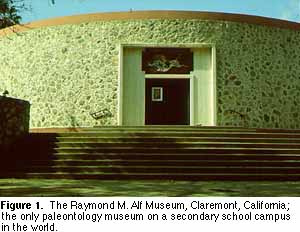 At The Raymond M. Alf Museum of Paleontology, high school students have the rare opportunity to learn what goes on behind the scenes at a museum which focuses on
paleontology. The Alf Museum is part of The Webb Schools of California, a private
secondary school and the only high school in the world with a paleontology museum on
campus. The museum was founded by a teacher, Raymond Alf. He had an interest in
paleontology and began taking students on field trips in search of fossils in the 1930's. In
1937, the skull of a new species of peccary or pig, Dyseohyus fricki, was found. This
important discovery inspired Alf to devote himself to paleontology and teaching. For the next
40 years he led numerous field expeditions with students during which thousands of fossils
were collected. These fossils are now housed in The Raymond M. Alf Museum of
Paleontology (established 1968).
At The Raymond M. Alf Museum of Paleontology, high school students have the rare opportunity to learn what goes on behind the scenes at a museum which focuses on
paleontology. The Alf Museum is part of The Webb Schools of California, a private
secondary school and the only high school in the world with a paleontology museum on
campus. The museum was founded by a teacher, Raymond Alf. He had an interest in
paleontology and began taking students on field trips in search of fossils in the 1930's. In
1937, the skull of a new species of peccary or pig, Dyseohyus fricki, was found. This
important discovery inspired Alf to devote himself to paleontology and teaching. For the next
40 years he led numerous field expeditions with students during which thousands of fossils
were collected. These fossils are now housed in The Raymond M. Alf Museum of
Paleontology (established 1968).

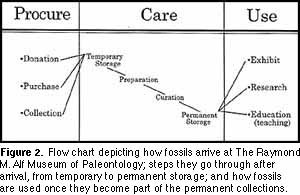
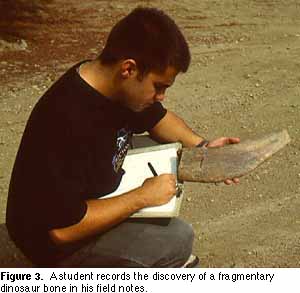 On Alf Museum expeditions, students keep their own sets of field notes (Figure 3) which are eventually placed into the archives of the museum. Later, fossils collected by students are curated into the permanent collections of the museum by these same students using the field notes. Thus, students learn that fossils retain their maximum scientific value only through proper field documentation.
On Alf Museum expeditions, students keep their own sets of field notes (Figure 3) which are eventually placed into the archives of the museum. Later, fossils collected by students are curated into the permanent collections of the museum by these same students using the field notes. Thus, students learn that fossils retain their maximum scientific value only through proper field documentation.
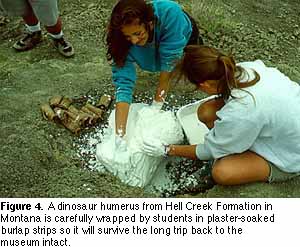 The last way fossils are commonly recovered in the field is through screenwashing. This
method is effective for recovering centimeter-millimeter size fossils of small-bodied
vertebrates that were concentrated in one area by rivers or streams. When a concentration of
these small fossils (representing teeth and the skeletal fragments of vertebrates) is located,
pieces of float can be picked up immediately. However, to recover large numbers of
specimens and those too small to see with the naked eye, the rock is washed in a wood box
lined with very fine screen ( see Figure 5). The fossils and some rock are left behind while most of the unwanted rock material washes through the screen. The rock-fossil concentrate is then dried and bagged for transport. Back at the museum, fossils are separated from the concentrate using a microscope. Many small species of vertebrates were first discovered using this screenwashing technique.
The last way fossils are commonly recovered in the field is through screenwashing. This
method is effective for recovering centimeter-millimeter size fossils of small-bodied
vertebrates that were concentrated in one area by rivers or streams. When a concentration of
these small fossils (representing teeth and the skeletal fragments of vertebrates) is located,
pieces of float can be picked up immediately. However, to recover large numbers of
specimens and those too small to see with the naked eye, the rock is washed in a wood box
lined with very fine screen ( see Figure 5). The fossils and some rock are left behind while most of the unwanted rock material washes through the screen. The rock-fossil concentrate is then dried and bagged for transport. Back at the museum, fossils are separated from the concentrate using a microscope. Many small species of vertebrates were first discovered using this screenwashing technique.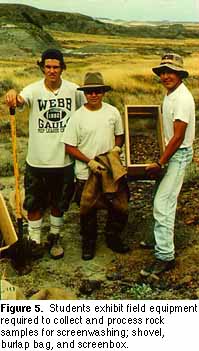 When specimens are offered as a donation, the staff needs to consult the institutional
Accessions Policy as well as take many factors under consideration. First, does the donation
match the staff's field of expertise? For example, if archaeological objects are offered as a
donation to the Alf Museum whose staff are paleontologists, why accept the gift? Staff have
limited knowledge of archaeology and the specimens are incompatible with the mission of
the museum. Second, is the availability of suitable storage or display space a problem? Can
the donation be properly cared for with the facilities or resources at hand? A museum with
limited display and storage space will not be able to accept a huge sauropod dinosaur
skeleton. The facilities to properly care for the specimen are not available. Third, ethical
issues may need to be addressed because specimens offered as a donation could have been
obtained illegally. Who is the legal owner of the specimens? Were they collected or
purchased legally? Fossils offered for donation from a foreign country have to be carefully
reviewed because antiquities regulations of most countries do not allow the removal of
fossils. Finally, do fossils offered for donation have associated field data (where the specimen was collected)? As mentioned previously, fossils without field data have limited scientific value because their age and the geologic horizon from which they were collected will always be uncertain. If the specimen lacks field data, does its scientific, exhibit, or educational value warrant accepting it? Fossils and other types of specimens have to be carefully reviewed on a case by case basis before being accepted for inclusion into the permanent collections.
When specimens are offered as a donation, the staff needs to consult the institutional
Accessions Policy as well as take many factors under consideration. First, does the donation
match the staff's field of expertise? For example, if archaeological objects are offered as a
donation to the Alf Museum whose staff are paleontologists, why accept the gift? Staff have
limited knowledge of archaeology and the specimens are incompatible with the mission of
the museum. Second, is the availability of suitable storage or display space a problem? Can
the donation be properly cared for with the facilities or resources at hand? A museum with
limited display and storage space will not be able to accept a huge sauropod dinosaur
skeleton. The facilities to properly care for the specimen are not available. Third, ethical
issues may need to be addressed because specimens offered as a donation could have been
obtained illegally. Who is the legal owner of the specimens? Were they collected or
purchased legally? Fossils offered for donation from a foreign country have to be carefully
reviewed because antiquities regulations of most countries do not allow the removal of
fossils. Finally, do fossils offered for donation have associated field data (where the specimen was collected)? As mentioned previously, fossils without field data have limited scientific value because their age and the geologic horizon from which they were collected will always be uncertain. If the specimen lacks field data, does its scientific, exhibit, or educational value warrant accepting it? Fossils and other types of specimens have to be carefully reviewed on a case by case basis before being accepted for inclusion into the permanent collections.